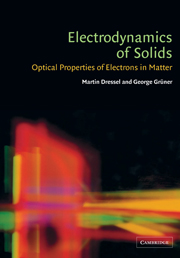Book contents
- Frontmatter
- Contents
- Preface
- 1 Introduction
- PART ONE CONCEPTS AND PROPERTIES
- 2 The interaction of radiation with matter
- 3 General properties of the optical constants
- 4 The medium: correlation and response functions
- 5 Metals
- 6 Semiconductors
- 7 Broken symmetry states of metals
- PART TWO METHODS
- PART THREE EXPERIMENTS
- PART FOUR APPENDICES
- Index
4 - The medium: correlation and response functions
Published online by Cambridge University Press: 20 May 2010
- Frontmatter
- Contents
- Preface
- 1 Introduction
- PART ONE CONCEPTS AND PROPERTIES
- 2 The interaction of radiation with matter
- 3 General properties of the optical constants
- 4 The medium: correlation and response functions
- 5 Metals
- 6 Semiconductors
- 7 Broken symmetry states of metals
- PART TWO METHODS
- PART THREE EXPERIMENTS
- PART FOUR APPENDICES
- Index
Summary
In the previous chapters the response of the medium to the electromagnetic waves was described in a phenomenological manner in terms of the frequency and wavevector dependent complex dielectric constant and conductivity. Our task at hand now is to relate these parameters to the changes in the electronic states of solids, brought about by the electromagnetic fields or by external potentials. Several routes can be chosen to achieve this goal. First we derive the celebrated Kubo formula: the conductivity given in terms of current–current correlation functions. The expression is general and not limited to electrical transport; it can be used in the context of different correlation functions, and has been useful in a variety of transport problems in condensed matter. We use it in the subsequent chapters to discuss the complex, frequency dependent conductivity. This is followed by the description of the response to a scalar field given in terms of the density–density correlations. Although this formalism has few limitations, in the following discussion we restrict ourselves to electronic states which have well defined momenta. In Section 4.2 formulas for the so-called semiclassical approximation are given; it is utilized in later chapters when the electrodynamics of the various broken symmetry states is discussed. Next, the response to longitudinal and transverse electromagnetic fields is treated in terms of the Bloch wavefunctions, and we derive the well known Lindhard dielectric function: the expression is used for longitudinal excitations of the electron gas; the response to transverse electromagnetic fields is accounted for in terms of the conductivity.
Information
- Type
- Chapter
- Information
- Electrodynamics of SolidsOptical Properties of Electrons in Matter, pp. 71 - 91Publisher: Cambridge University PressPrint publication year: 2002
Accessibility standard: Unknown
Why this information is here
This section outlines the accessibility features of this content - including support for screen readers, full keyboard navigation and high-contrast display options. This may not be relevant for you.Accessibility Information
- 1
- Cited by
